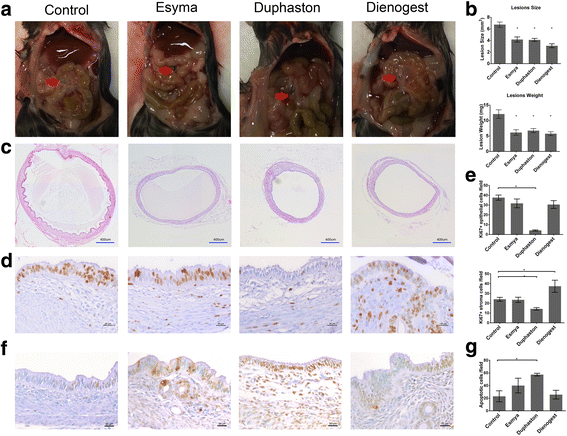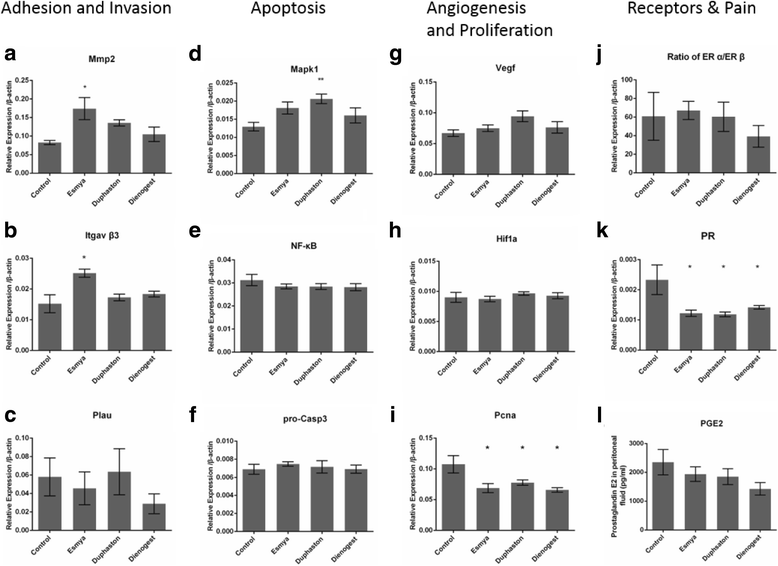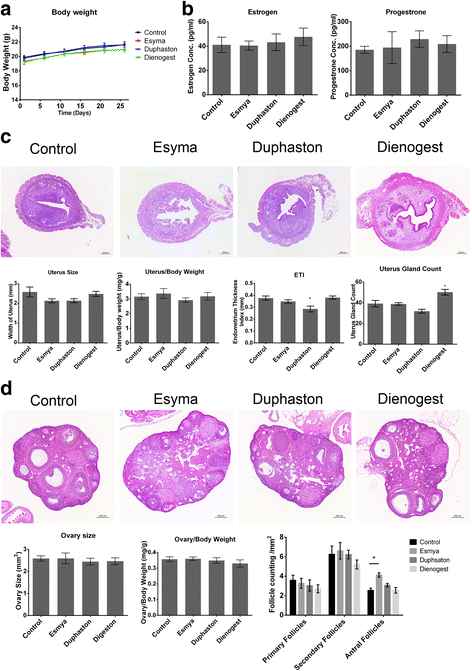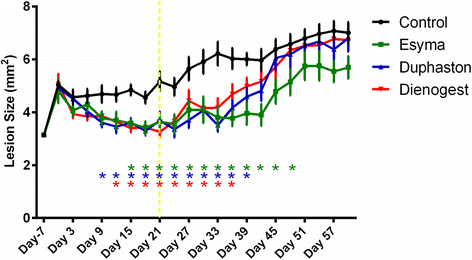Efficacy, safety and recurrence of new progestins and selective progesterone receptor modulator for the treatment of endometriosis: a comparison study in mice
- PMID: 29615065
- PMCID: PMC5883298
- DOI: 10.1186/s12958-018-0347-9
Efficacy, safety and recurrence of new progestins and selective progesterone receptor modulator for the treatment of endometriosis: a comparison study in mice
Abstract
Background: Current medical treatments for endometriosis are very limited. Progestin and selective progesterone receptor modulators (SPRM) are developed but their efficacy, safety, mechanism and recurrence in endometriosis are not fully studied.
Methods: In order to compare therapeutic, side effects and therapeutic actions of Esmya, Duphaston and Dienogest in endometriosis. Experimental endometriosis was induced by either intraperitoneal or subcutaneous mouse endometrium transplantation. Lesion size, weight and histology at the end of intervention were compared. Expression of related markers in the endometriotic lesions were examined. Body, uterus and ovary weights, endometrial glands and thickness (ETI), and follicle count were measured. For recurrent study, lesion growth before and after intervention was monitored.
Results: After Esmya, Duphaston, Dienogest treatment, lesion size and weight were significantly decreased. Proliferation Pcna expression was significantly decreased in all groups, but proliferation cells were significantly decreased only in Duphaston group. Apoptosis Mapk1 expression and TUNEL-positive cells were significantly increased in Duphaston group. Adhesion Mmp2 and Itgavβ3 expression were significantly increased in Esmya group. Plau, Hif1α and Vegfa expression, peritoneal fluid PGE2 levels, and ERα and ERβ expression were not affected; while PR expression was significantly lower in all groups. Endometrial gland count in uterus was significantly increased in Dienogest group, ETI was significantly decreased in Duphaston group, and AFC were significantly increased in Esmya group. Upon treatment cessation, lesion growth rebound quickly in Dienogest and Duphaston groups, but slowly in Esmya group.
Conclusion: Esmya, Duphaston and Dienogest are effective anti-endometriosis drugs targeting proliferation, apoptosis and adhesion. Esmya, Duphaston and Dienogest are all well tolerable, although endometrial glandular hyperplasia was found in Dienogest, endometrial atrophy in Duphaston, follicle accumulation in Esmya.
Keywords: Endometrium; Progestin; Selective progesterone receptor modulator.
Conflict of interest statement
Ethics approval
All of the animal experiments were approved from the Animal Experimentation Ethics Committee, The Chinese University of Hong Kong.
Consent for publication
Not applicable.
Competing interests
The authors declare that they have no competing interests.
Publisher’s Note
Springer Nature remains neutral with regard to jurisdictional claims in published maps and institutional affiliations.
Figures




Similar articles
-
New treatment strategy for endometriosis using progestin-primed ovarian stimulation with dienogest: A prospective cohort study, comparison of dienogest versus dydrogesterone.Reprod Biol. 2021 Mar;21(1):100470. doi: 10.1016/j.repbio.2020.100470. Epub 2020 Dec 14. Reprod Biol. 2021. PMID: 33333410
-
Progestin effects on expression of AKR1C1-AKR1C3, SRD5A1 and PGR in the Z-12 endometriotic epithelial cell line.Chem Biol Interact. 2013 Feb 25;202(1-3):218-25. doi: 10.1016/j.cbi.2012.10.028. Epub 2012 Nov 23. Chem Biol Interact. 2013. PMID: 23183084
-
Dienogest regulates apoptosis, proliferation, and invasiveness of endometriotic cyst stromal cells via endoplasmic reticulum stress induction.Mol Hum Reprod. 2020 Jan 1;26(1):30-39. doi: 10.1093/molehr/gaz064. Mol Hum Reprod. 2020. PMID: 31814016
-
Dienogest: a review of its use in the treatment of endometriosis.Drugs. 2010 Nov 12;70(16):2073-88. doi: 10.2165/11206320-000000000-00000. Drugs. 2010. PMID: 20964453 Review.
-
Progesterone receptor ligands for the treatment of endometriosis: the mechanisms behind therapeutic success and failure.Hum Reprod Update. 2020 Jun 18;26(4):565-585. doi: 10.1093/humupd/dmaa009. Hum Reprod Update. 2020. PMID: 32412587 Free PMC article.
Cited by
-
The Flavonoid Baicalein Negatively Regulates Progesterone Target Genes in the Uterus in Vivo.J Nat Prod. 2022 Jan 28;85(1):237-247. doi: 10.1021/acs.jnatprod.1c01008. Epub 2021 Dec 22. J Nat Prod. 2022. PMID: 34935393 Free PMC article.
-
Selective Progesterone Receptor Modulators-Mechanisms and Therapeutic Utility.Endocr Rev. 2020 Oct 1;41(5):bnaa012. doi: 10.1210/endrev/bnaa012. Endocr Rev. 2020. PMID: 32365199 Free PMC article. Review.
-
New Therapeutics in Endometriosis: A Review of Hormonal, Non-Hormonal, and Non-Coding RNA Treatments.Int J Mol Sci. 2021 Sep 28;22(19):10498. doi: 10.3390/ijms221910498. Int J Mol Sci. 2021. PMID: 34638843 Free PMC article. Review.
-
Receptor Tyrosine Kinase Inhibitor Sunitinib as Novel Immunotherapy to Inhibit Myeloid-Derived Suppressor Cells for Treatment of Endometriosis.Front Immunol. 2021 Jul 22;12:641206. doi: 10.3389/fimmu.2021.641206. eCollection 2021. Front Immunol. 2021. PMID: 34367125 Free PMC article.
-
Integrated analysis of single-cell and bulk transcriptomic data reveals altered cellular composition and predictive cell types in ectopic endometriosis.Front Med (Lausanne). 2025 Jul 18;12:1641982. doi: 10.3389/fmed.2025.1641982. eCollection 2025. Front Med (Lausanne). 2025. PMID: 40757199 Free PMC article.
References
-
- Zeitoun K, Takayama K, Sasano H, Suzuki T, Moghrabi N, Andersson S, Johns A, Meng L, Putman M, Carr B, Bulun SE. Deficient 17beta-hydroxysteroid dehydrogenase type 2 expression in endometriosis: failure to metabolize 17beta-estradiol. J Clin Endocrinol Metab. 1998;83:4474–4480. - PubMed
MeSH terms
Substances
LinkOut - more resources
Full Text Sources
Other Literature Sources
Medical
Research Materials
Miscellaneous

